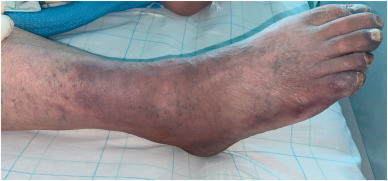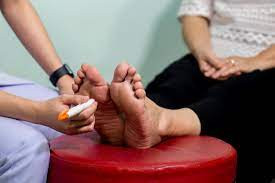Definition
Raynaud's disease, also known as Raynaud's phenomenon or Raynaud's syndrome, is a vascular disorder that typically occurs in the fingers and toes. Raynaud's disease is a rare vascular disorder where blood vessels narrow in response to cold temperatures or stress. The fingers and toes may feel stiff and cold. While this condition generally does not cause serious problems, it can sometimes be a sign of a more serious medical condition that affects the quality of life for those affected. Women are more commonly affected by this disease compared to men.
Causes
The exact cause of Raynaud's disease is not known, but it is believed to result from an exaggerated response of blood vessels to cold temperatures or stress. When the body is exposed to cold temperatures or stress, the blood vessels in the fingers and toes narrow. During a brief period, there is a reduction in blood flow to the fingers and toes. Over time, these small blood vessels may gradually thicken, causing an increasing resistance to the restricted blood flow. Exposure to cold, such as immersing hands in cold water, taking something from the refrigerator or freezer, or simply being in a cold environment, can trigger an attack. In some individuals, emotional stress can also be a trigger for attacks.
There are two main types of Raynaud's syndrome based on their causes:
1. Primary Raynaud's Disease (Raynaud's Primary)
This type is the most common and is not caused by any specific medical condition. Symptoms can be mild, and many affected individuals may not seek medical help. This type can resolve on its own without complications or causing significant stress.
2. Secondary Raynaud's Phenomenon (Raynaud's Secondary)
An underlying medical condition causes this type and is less common than the primary type. Although less common, this type is usually causing more severe symptoms. Secondary Raynaud's symptoms typically appear around 40 or later, later than the onset of Primary Raynaud's. Some conditions that can cause Secondary Raynaud's include:
- Connective tissue disorders such as scleroderma
- Lupus
- Vascular diseases
- Carpal Tunnel Syndrome (CTS), causes numbness and pain in the hands due to pressure on the main nerve in the hand
- Repetitive movements or vibrations, such as typing, playing the piano, performing repetitive motions for extended periods, and using vibrating tools
- Smoking, which can narrow blood vessels
- Injuries to the hands and feet
- Certain medications that have a vasoconstrictive effect
Risk factor
Risk factors for Primary Raynaud's include:
- Female gender
- Age between 15 and 30 years
- Living in a cold environment
- First-degree family history (parents, siblings, or children) of Raynaud's disease
Risk factors for Secondary Raynaud's involve:
- Having certain medical conditions such as scleroderma and lupus
- Working with activities that cause repetitive injuries to the hands or feet
- Exposure to certain substances, such as smoking and medications can constrict blood vessels.
Symptoms
The symptoms and signs of Raynaud's disease that can be observed include:
- Fingers or toes feeling cold
- Changes in skin color in response to cold temperatures or stress
- A sensation of numbness or tingling or a painful, electric shock-like feeling that occurs when the hands are warmed or the stress trigger is removed
During an attack, the affected skin area initially turns white. Subsequently, the skin color may turn bluish, feeling of cold and numbness. Once in a warm environment or after warming up, blood flow improves, and the skin area may become red, throbbing, tingling, or swollen. The return of blood flow can take about 15 minutes after warming up. Although Raynaud's disease mainly occurs in the fingers and toes, this condition can also affect other areas of the body, such as the nose, lips, ears, and nipples.
Diagnosis
To diagnose Raynaud's disease, the doctor will inquire about your medical history and the symptoms you are experiencing and conduct a physical examination. Additional tests are performed to rule out the possibility of underlying medical conditions causing Raynaud's symptoms rather than to confirm the presence of Raynaud's disease itself. These tests may include examinations for conditions underlying the symptoms, such as autoimmune diseases (where the immune system attacks the body itself) or connective tissue diseases.
Management
Management of Raynaud's disease depends on the severity of symptoms and whether there are specific medical conditions in the patient that may trigger Raynaud's symptoms. Therapy aims to reduce the frequency and severity of attacks, prevent tissue damage, and address underlying medical conditions if present.
For mild symptoms, management measures may be sufficient, including protecting the body parts from cold temperatures. Medications are used for more severe symptoms, such as dilating blood vessels to improve blood flow. A doctor may recommend nerve surgery procedures or local anaesthetic injections in severe cases.
When an attack occurs, actions you can take include warming your hands, feet, and affected areas by:
- Moving to a warm room
- Waving your hands and feet
- Placing your hands in a warmer spot
- Running warm water, not cold, over your hands and feet
- Gently massage your hands and feet
Complications
In most people, Raynaud's disease does not impose limitations but can affect the quality of life. In severe cases of secondary Raynaud's, tissue damage can occur, although it is rare. If blood flow is completely blocked, it can lead to skin ulcers that are challenging to heal. In extreme cases that go untreated, when the tissues in the hands or feet die, amputation of the affected parts may be necessary.
Prevention
Because the exact cause is not known, there is no specific way to prevent Raynaud's disease. However, there are ways to prevent attacks, such as:
- Wear thick clothing, gloves, head coverings, scarves, socks, and closed shoes when outside in cold temperatures. Also, cover the tips of your nose and ears if they are sensitive to the cold
- Wearing gloves when taking food out of the refrigerator or freezer
- Adjusting the air conditioner temperature to avoid excessive cold
- If the indoor temperature is cold, wear socks, even when sleeping
- Avoiding smoking
- Exercise can improve blood flow and have many health benefits. However, be cautious when exercising in cold environmental temperatures
- Managing stress
- Avoid drastic temperature changes, such as moving from a hot outdoor space to a cold indoor space.
When to see a doctor?
If you experience pain or numbness in the hands or feet due to cold temperatures or stress factors, it is advisable to consult with a doctor for further evaluation. Moreover, you can also undergo disease screening if this condition arises due to an underlying medical condition.
Looking for more information about other diseases? Click here!
- dr Hanifa Rahma
Raynaud's disease - Diagnosis and treatment - Mayo Clinic. Mayoclinic.org. (2022). From https://www.mayoclinic.org/diseases-conditions/raynauds-disease/diagnosis-treatment/drc-20363572. [Accessed April 5, 2022]
Topics, H. (2022). Raynaud's Disease | Raynaud's Syndrome | MedlinePlus. Medlineplus.gov. From https://medlineplus.gov/raynaudsdisease.html.[Accessed April 5, 2022]
Raynaud’s Disease and Raynaud’s Syndrome. WebMD. (2022). From https://www.webmd.com/arthritis/raynauds-phenomenon.[Accessed April 5, 2022]
Raynaud's disease: Treatment, causes, and symptoms. Medicalnewstoday.com. (2022).From https://www.medicalnewstoday.com/articles/176713.[Accessed April 5, 2022]












